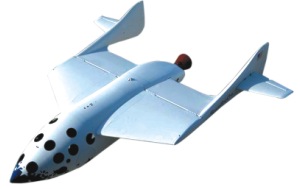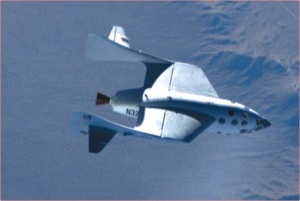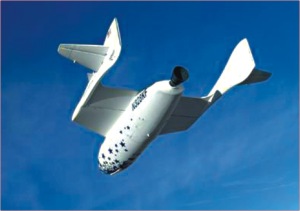Private
spaceship rolles into the space
Compiled
by Nabila Quamrun Nahar
SpaceShipOne,
what is likely to become world's first "spacebus", has won
a 10 million US $ prize. The bounty, dubbed the Ansari X Prize has
been announced since 1996, to the first privately funded spaceship,
that successfully launches three humans or the equivalent weight to
a sub-orbital altitude of 100 km on two consecutive flights within
two weeks. The X-Prize is administered by the Missouri-based X-Prize
Foundation, and funded by the Dallas based Ansari family. More than
two dozen teams around the world are involved in the competition.The
intention was to inspire an era of space tourism in which spaceflight
is not just the domain of government agencies such as NASA, in other
words to boost commercial-space travel.
 The
SpaceShipOne project cost less than US$30 million to plan,
develop and execute, less than a 10th of what it costs the US government
space agency NASA for a single, US$500 million space shuttle launch.
The
SpaceShipOne project cost less than US$30 million to plan,
develop and execute, less than a 10th of what it costs the US government
space agency NASA for a single, US$500 million space shuttle launch.
The first flight
of SpaceShipOne was on September, 29 .63year old South African pilot
Michael Melvill was on board . It landed safely in the desert of Mojave
airport, north of Los Angeles after a wild corkscrew-like ascent into
space. And finally completing the second flight by reaching more than
114 kilometers beyond the Earth's surface ,the spacecraft touched
down on a section of the Mojave desert on October 4. The flight was
commanded by 51 year old Brian Binnie.The SpaceShipOne team deliberately
chose this day as the date of their second attempt because of its
role in aerospace history: Forty-seven years ago, the Soviets put
the world's first satellite, Sputnik 1, into orbit kicking off the
first space race.
The
flight plan was similar to that for the past two spaceflights: With
SpaceShipOne attached to its underbelly, the White Knight
carrier airplane took off from the Mojave Airport and rose to a height
of 47,000 feet .Then SpaceShipOne unhooked from the White
Knight and fired up its rocket engine for 84 seconds, reaching velocities
more than three times the speed of sound.
At
the top of the ride, Binnie experienced about three and a half minutes
of weightlessness and had time to take pictures as well as play with
a paper model of SpaceShipOne for the video camera's benefit.
SpaceShipOne's wings were folded into a self-stabilizing,
high-drag configuration for atmospheric re-entry, then were folded
back into a glider configuration for landing. After an airshow-style
fly-by, the White Knight landed as well.
Thousands watched
from the Mojave Airport as SpaceShipOne's rocket plume streaked straight
up into the morning sky. Among the VIP headliners were Richard Branson,
head of the British-based Virgin Group and the world's latest space
tourism investor; and Marion Blakey, head of the Federal Aviation
Administration.
After Binnie landed,
Blakey presented him with an astronaut pin and paid tribute to him
as well as Michael Melvill, the only astronauts to earn their wings
from the FAA rather than NASA or the military.
Binnie said the
space mission was "a fantastic experience," with the "bright
pearl" of the California coast visible beneath the blackness
of space. "It's a fantastic view; it's a fantastic feeling. There
is a freedom there and a sense of wonder that - I tell you what -
you all need to experience," said Binnie.
"History
was made today, and we begin an era of commercial space travel,"
Peter Mitchell, director of New Mexico Office for Space Commercialization,
told reporters at the Mojave Airport , just a couple of hours after
the SpaceShipOne rocket plane's prize-winning flight.
"We are proud
to announce that SpaceShipOne has made two flights to 100km and has
won the Ansari X Prize," said the X prize Foundation president
Peter Diamandis.
 President
Bush phoned the winning team to offer his congratulations, Peter Diamandis
said. "He said that it was great to see the spirit of enterprise
alive in America and opening up the space frontier," "What
we finally have here, after 40 years of waiting, is the beginning
of the personal spaceflight revolution," said Diamandis.
President
Bush phoned the winning team to offer his congratulations, Peter Diamandis
said. "He said that it was great to see the spirit of enterprise
alive in America and opening up the space frontier," "What
we finally have here, after 40 years of waiting, is the beginning
of the personal spaceflight revolution," said Diamandis.
"What's going
to happen a few years down the road when space tourism is available
for everyone is going to be amazing," said Microsoft co-founder
Paul Allen. He has sunk more than $20m into this project. "I'm
looking forward to that day and hopefully we'll all be in space before
you know it."
Aviation
pioneer Burt Rutan, who conceived SpaceShipOne and whose
company Scaled Composites built the vehicle, said he was "so
proud of my team," the BBC said. Burt Rutan, creator of Voyager,
the plane that completed the first non-stop, non-refuelled flight
around the world in 1986.
So the race has
begun for the suborbital passenger business, even before it's truly
a business. Today, Mojave Airport certainly has the inside track not
only because it's the home base for the SpaceShipOne team, but also
because Richard Branson plans to run his "Virgin Galactic flights"
from here in 2007.
Branson says he's
already sold "a lot of real tickets" for those future flights
at $190,000 each including a spot for British advertising guru Trevor
Beattie of TBWA/London, who attended the past week's proceedings in
Mojave.
New Mexico will
be home of the X Prize Cup, the annual rocket festival conceived as
a follow-up to the Ansari X Prize. British-based Starchaser Industries
already has opened an office in New Mexico and plans to begin flying
suborbital space vehicles there as early as 2006.
Oklahoma serves
as the home base for two X Prize contenders, Rocketplane Ltd. and
TGV Rockets. The Oklahoma Space Industry Development Authority plans
to complete its federal spaceport application by next summer, executive
director Bill Khourie said. And as of September 29, reservations are
being taken for Rocketplane suborbital flights from Oklahoma starting
in 2007, said Jane Reifert of Incredible Adventures. List price is
$99,500.
 Russia
operates the only spaceport that has actually taken paying passengers
into orbit the Baikonur Cosmodrome in Kazakhstan. The Russian-based
Suborbital Corp. is developing its own analog to SpaceShipOne,
known as Cosmopolis XXI, which could be flying by 2007.
Russia
operates the only spaceport that has actually taken paying passengers
into orbit the Baikonur Cosmodrome in Kazakhstan. The Russian-based
Suborbital Corp. is developing its own analog to SpaceShipOne,
known as Cosmopolis XXI, which could be flying by 2007.
Australia already
has an agreement to launch Russian spacecraft from its Woomera Range,
and Virginia-based Space Adventures the company that helped send millionaires
Dennis Tito and Mark Shuttleworth into space on Russian rocket ships
says it may select an Australia site for a suborbital spaceport by
the end of the year.
"I think
you'll see the first Canadian, the first Russian, the first British,
the first Romanian -- all the X Prize teams outside the US will continue
their work to become the first of their nation to carry out a first
private flight into space," said X Prize founder Peter Diamandis.
Brian Feeney,
who leads a rival X Prize effort called the da Vinci Group, said that
he was determined to continue.
"If we come
in second to the most accomplished aerospace engineer of this and
the last century, that's not too bad," Feeney said. "We
have a singular goal: to fly. If we fly, we win."
Space Transport
Corp., another X Prize rival, sent its congratulations to the SpaceShipOne
team and announced that it would still go ahead with a test launch
of its Rubicon 2 rocket on Oct. 16 or 17 from the Makah Indian Reservation
on the coast of Washington state's Olympic Peninsula.
The Ansari X Prize
is modeled after the $25,000 Orteig Prize that was won by trans-Atlantic
aviator Charles Lindbergh in 1927 .
Lindbergh's flight
helped to demonstrate that air travel could be safe and affordable
for ordinary people and blazed the trail for commercial airlines -
a feat SpaceShipOne seems poised to repeat for space travel. But is
this just another firework in hopes of bringing the public into space
or the next revolution in flight?
